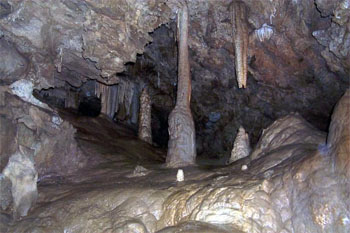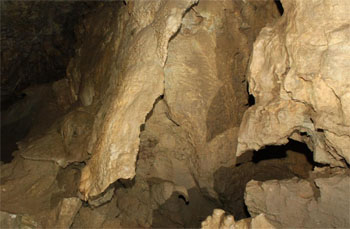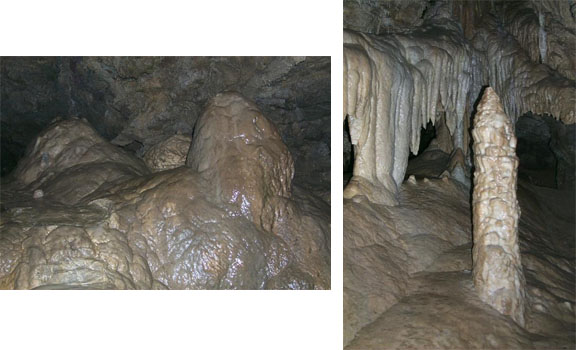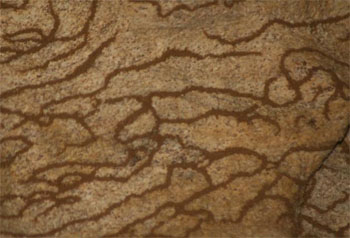Miller's Chapel
Miller’s Chapel is one of the best rooms in which to see nearly all of the depositional formations present at the Oregon Caves. Examples of erosional features can also be seen in the room, making Miller’s Chapel a good representation of the wide variety of cave features.
Geology
Room Development
Miller’s Chapel was once filled with muddy water, as indicated by the presence of vermiculations (Bini, Gori, and Gori). This water helped shape the room and created more open space before it drained, which then established a depositional environment (Veni 438).
Several speleogens are present in Miller’s Chapel, though, such as a small domepit to the right of the steps out of the room. This domepit has rillenkarren: solution grooves about one centimeter wide that formed as acidic water ran do wn the marble in rivulets (Bates and Jackson 569; Lundberg 315). Closer to the stairs and next to the domepit, a ledge of flowstone—known as a canopy—hangs over open air where its underside has been eroded (Bates and Jackson 97).
wn the marble in rivulets (Bates and Jackson 569; Lundberg 315). Closer to the stairs and next to the domepit, a ledge of flowstone—known as a canopy—hangs over open air where its underside has been eroded (Bates and Jackson 97).
Cave Formations
Miller’s Chapel has great examples of most cave formations. One of the longest soda straws, about 14 inches, is located above and in front of the chapel area (Roth 32). Miller’s Chapel also provides an excellent opportunity to see columns, and columns in the making. A tall broomstick-shaped column is in the middle of the room. Nearby, several stalactites and stalagmites reach towards each other. Eventually, they will connect.
In fact, Miller’s Chapel contains many of the largest stalactites in the entire cave, with some that are over several feet in length. This room also has some of the largest stalagmites, some more than a foot in diameter. Many of the stalagmites have an unusual shape, due to differences in water flow. Faster water flow leads to more splattering, resulting in a rounder shape. Also, the amount of dissolved calcite can influence stalagmite shape. Formations with high amounts of dissolved calcite in the water tend to have a sharper point, cylindrical body, and are taller. The larger, lumpier, and low-lying formations represent water that has a low, diluted concentration of dissolved calcite. It therefore has time to deposit calcite far from the drips. They form during wet climates. (Dreybrodt 543-545; Roth 32).
Also found in Miller's Chapel are vermiculations, which look like worms clinging to the walls and ceiling. Of course, these are not actual living worms, they are sediment deposits. The room drained slowly enough to allow the clay particles to glob together and accumulate into fanciful patterns (Bini, Gori, and Gori; Roth 32-33).
Below and to the left of the path between Miller’s Chapel and the Ghost Room, rimstone dams can be seen. These are maze-like calcite formations developed in flowing water where the calcite builds up in dams. Water flow changes because of the irregularities in the shape of the floor. These obstructions create turbulence, which increases the loss of carbon dioxide and causes deposition (Hill and Forti 691; Palmer 277).

Bates, Robert and Julia Jackson, ed. Glossary of Geology. Alexandria: American Geological Institute, 1987. 97, 569.
Bini, Alfredo, Cavalli Gori and Silvio Gori. “A Critical Review of Hypotheses on the Origin of Vermiculations”. International Journal of Speleology. 1978.Volume 10, Issue 1.
Dreybrodt, Wolfgang. “Speleothem Deposition.” Encyclopedia of Caves. David Culver and William White, ed. Burlington: Elsevier Academic Press, 2005. 543-548.
Hill, Carol and Paolo Forti. “Speleothems: Carbonate.” Encyclopedia of Caves and Karst Science. John Gunn, ed. New York: Fitzroy Dearborn, 2004. 691-692.
Lundberg, Joyce. “Karren.” Encyclopedia of Caves. David Culver and William White, ed. Burlington: Elsevier Academic Press, 2005. 315-321.
Palmer, Arthur. “Influence of geology on cave patterns.” Cave Geology. Dayton: Cave Books, 2007. 277.
Roth, John. “Interpretive Manual for the Monument’s Showcave”. Cave Junction: Oregon Caves National Monument, 2011. 32-34.
Veni, George. “Passages.” Encyclopedia of Caves. David Culver and William White, ed. Burlington: Elsevier Academic Press, 2005. 436-440.